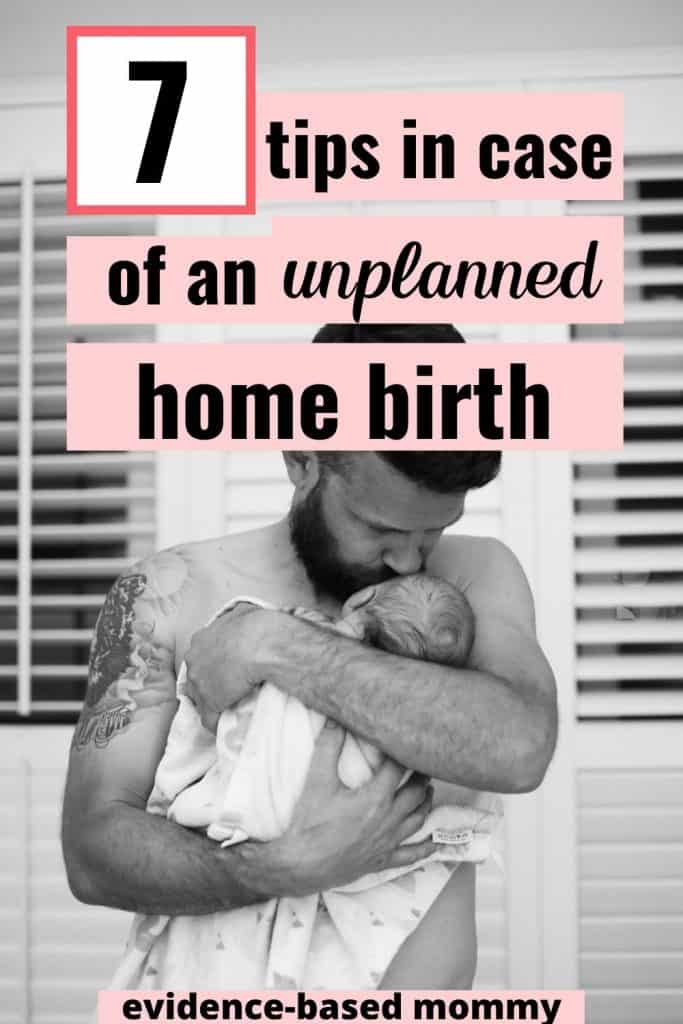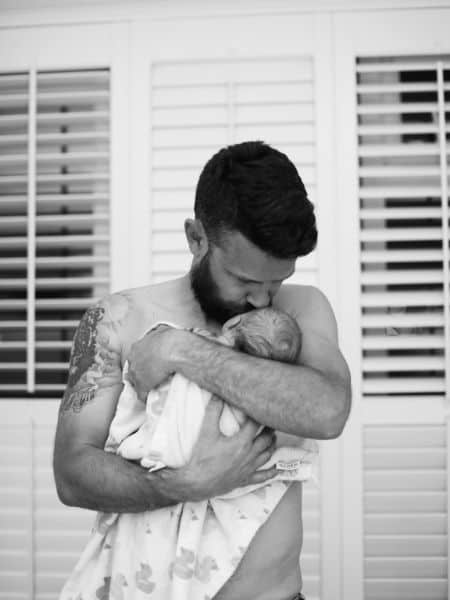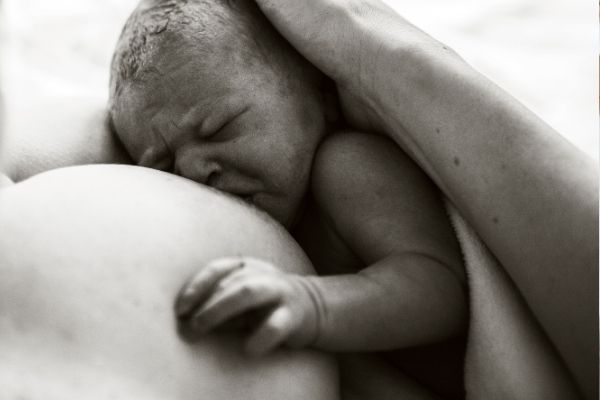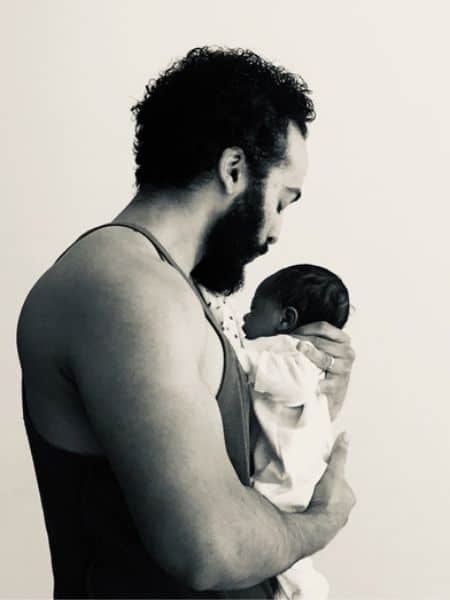No matter how much you plan, there’s always a chance for surprises to happen when it comes to birth. Maybe you’ll have a long labor, or maybe it’ll be super short! If it’s short enough, you could even end up with an accidental home birth.
While I have had some close calls on getting to the hospital on time (read about both my 3-hour second birth and my at first stalled-out, but then VERY fast fourth birth below), and I have some lovely natural birth stories, I’ve never had a home birth, either unplanned or on purpose. So this was simply not an experience I could speak to.
RELATED: Natural birth or epidural, which should you choose (from someone who has done both)
RELATED: Stalled out labor – what to do when contractions stop
Fortunately, I met my friend Mo. Mo’s second child was born at home, and he graciously agreed to tell me his and his wife’s home birth story. So if you’re wondering what to do in an emergency home birth, here’s what you need to know.
Table of Contents
Mo’s experience with an accidental home birth
Every birth story is distinctive. However, as I sat down recalling the chain of events that led to me delivering my daughter at home, I couldn’t help but feel lucky.

We were planning for a hospital birth, but through an unexpected chain of events, I was left helping my wife give birth unassisted. It was frightening, but ultimately amazing!
Many parents-to-be have parental questions, especially when it comes to all things baby-related, but very few dads would think they needed to learn what to do in the extraordinary event of an unplanned home birth.
In this article, I’ll reveal the culmination of events that lead to me delivering my own daughter when my wife gave birth at home, with no pain killers and zero assistance from the paramedics.
Learning how to stay calm when labor happens quickly can be hard, so let’s start at the beginning…
Early labor
My wife had begun having uncomfortable contractions a few days in a row, so I naturally predicted that the baby was coming soon. This was our 2nd child. With her first, my wife gave birth 8 days before her due date, so we expected our baby to arrive slightly early.
My wife had been very busy for the past few nights, so I was well aware of her usual waking patterns as she dealt with the aches and pains of the third trimester.

RELATED: Surviving the third trimester – Self-care for common pregnancy aches and pains
However, on this night, I didn’t hear her shuffle out of bed, so she was up for a few hours before me.
By the time I got out of bed, she was already having regular contractions. I decided to start timing contracts straight away to see what was going on.
Timing Contractions – unassisted birth story
As I started timing the contractions, I noticed they were coming very regularly and very close together. I was concerned, so I gave the hospital a call to let them know we were coming in soon.
A few weeks before, the hospital had advised us to only come in when contractions were close together, after they had talked to my wife on the phone. However, before I got through to the hospital birthing centre, my wife let out a scream of pain. She kneeled there, half on her feet and half on the ground, in complete disarray.
I didn’t need to question what had happened; it was obvious. Her waters had suddenly broken.
Seeing her anxiety and realizing that it would be very tricky to get us all (including our toddler) in my car quickly, I decided to call an ambulance. Although our bags had been packed the evening before, I hadn’t yet woken up our 2-year-old son. I knew it would be very hard to get him dressed and ready with all the commotion going on.
This choice proved to be a sensible one as we probably would never have made it to the hospital!
After I called the ambulance
As my wife stood there, arching as she dealt with intense transition contractions, I spoke nervously with the operator on the telephone.

I explained what was going on, and she let me know an ambulance was on its way and was close.
Everything was going really fast and by this point, we both knew our baby would be born at home, whether we liked it or not. This was not in the plans, and it was intimidating.
I quickly considered ways to make the living room a tranquil space. I dimmed the lights, gently laid out some pillows and covers and yelled across the room at Google Home to play waterfall music.
As my wife breathed through contractions, the operator gently asked me to check on the baby. She wanted to see if I could check roughly what position she was in.
As my wife cautiously opened her legs, I saw the unforgettable sight of the baby crowning.
Luckily, I had taken the time to read a few baby books. I remember a section titled “What to do when labor happens quickly.” All those images came flooding back.
I realized that my baby crowning meant she was coming very soon, so I nervously asked the operator “When is the ambulance coming?!”
She let me know they were nearby… but she also instructed me to gather a few non-medical items from around the house. I instantly got a weird feeling in the pit of my stomach that the ambulance may not take it in time.
Dealing with an older sibling during home birth
As I struggled to get these strange items, (for example, a shoelace. What was I going to do with a shoelace?) I knew things didn’t look good for us getting any professional help.
My wife was in intense pain, and I felt so helpless. It was already a terrifying experience.
But just as I thought things couldn’t get any worse, out jumped our 2-year-old son from the room next door!
He had slept through most of my wife’s labor, but on hearing his mother’s agonising yells of pain, he woke up and came crashing through the living room door. I remember he looked scared, worried, and confused, all at the same time.
I tried to settle him as quickly as possible while also taking instructions from the paramedic. To say that my son’s presence complicated things is an understatement.
The euphoria of delivering my child – an unassisted birth story
My wife had passed from active labor and through transition rapidly. She was ready to push the baby out now. There was no waiting for the ambulance.
I held her hand, tried to remain relaxed, and kept telling her everything would be alright (I was simultaneously taking instructions from the emergency operator and attending to our distressed toddler).
I remember the operator having to repeat herself over and over, not because I couldn’t hear her, but just because I was having difficulty processing. (Was I going to deliver my daughter by myself?!)
Time slowed down and each moment felt like a minute.
As my wife started to push, our daughter quickly started to show. Suddenly, her head popped out and I saw her gorgeous face for the first time.
It was a culminating sense of complete euphoria, followed by profound anxiety. It’s a feeling that’s almost impossible to describe, but that I will always remember.
The next few moments were filled with screams of agony from my wife, screams of shock by our toddler, screams of joy from our newborn and screams (well, it felt like it) of instructions from the operator.
So much was happening all at once, and it was difficult to catch my breath! But my wife needed coaching to complete the birth of our baby girl.
With another push from my wife, the rest of the baby followed all at once: Shoulders, back and bum, and finally our baby’s feet. I supported the baby’s head and body and wrapped her up in a clean towel.

I immediately praised my wife, telling her how proud I was of her.
She is the strongest person I know, and the fact she did it all without pain killers or pain relief was something that I think deserves a medal for in itself! I love our unassisted birth story.
How paramedics help after an accidental home birth
A few moments later, I heard a bang on the door as the paramedics finally made it. They walked in and were extremely surprised to see my wife holding our baby.
They promptly checked the baby over and gave her the all-clear. As we collected our things to get a more in-depth check at the local hospital, I felt both frustrated and relieved.
I was frustrated that the paramedics got there late, but totally in awe that my daughter was born happy and healthy at home.
Our baby girl weighed 6 pounds and 2 ounces and was perfectly healthy.
What to remember during an unexpected home birth
While it may be really scary to realize you will have to deliver your baby on your own, it can be a really empowering experience. Here’s a few things you should know:

Staying calm is the best thing you can do during labor
Whether, like me, you’re helping someone through an accidental home birth, or you’re the one actually in labor, the best thing you can do is stay calm. Focus on keeping your breathing slow, with your jaw relaxed. If you have some birth meditations (like these), put them on.
Unplanned home births are usually safe
The good thing is, if your baby is coming quickly enough for you to have an emergency home birth, that likely means your baby is in an ideal position in the birth canal and that everything is fine.
All that said: Don’t panic if you’re still at home and hit transition or even the pushing stage.
Getting a lot of towels or sheets ready is probably a good idea
Birth is a messy process. I mean, yes, you can do your birth at home in bed, but be prepared.
If you happen to have a (clean, brand-new) shower curtain, it can make for a great waterproof liner for your floor. You can then use whatever blankets, towels, or sheets you need to get comfortable.
If you need to push, go ahead and do so
Often if a medical provider isn’t there, a mother will be told to not push (even if her body is telling her to do so). This can happen in the hospital, if your nurse is waiting for the OB to come in, for example, but it can also happen if you’re waiting for paramedics at home.
Recent studies have shown that it is not good for mothers or their babies to fight the urge to push.
At the same time, partners, mom probably doesn’t need you yelling at them to push or telling them what to do. When there’s no epidural, she’ll feel when her body says to push (and when to take a break).
Bottom line: Listen to your body and do what you need to.
Immediately lay your baby on your chest, skin-to-skin
While you should have a blanket over your baby’s back, you’ll want to make sure she’s immediately laid on you, skin-to-skin. This act will keep her warmer, let you bond, and increase oxytocin levels (and besides that, there’s nothing better than holding your brand new baby against you).
RELATED: How to bond with baby and take care of yourself during the first 48 hours after birth
In addition, it’s a great idea to let your baby try to nurse. Don’t force it, just lay in a reclined position with your baby on your chest.

RELATED: Best positions for breastfeeding
She may rest for a little while, but soon enough her little head will be bobbing around, looking for your nipple. With only a little help, she’ll be able to find it and nurse on her own.
(BTW, if the placenta hasn’t delivered, and the umbilical cord is so short that your baby can’t reach your breast, it’s okay. Just place her on your belly and wait for the placenta to be delivered. After that, you can try breastfeeding).
Don’t cut or clamp the umbilical cord
If your baby is born before paramedics come, don’t cut the umbilical cord. Leave that to the professionals (who have properly sterilized tools).
On top of that, it is best for your baby to keep the umbilical cord intact for a while – until it stops pulsing, and possibly until the placenta is delivered. The intact cord will deliver the last bit of cord blood to your baby, which increases her iron stores for the months ahead.
Be ready for more contractions to deliver the placenta
You’re not quite done with labor once your baby is born. You will still have to deliver the placenta, which means you’ll have a few more contractions for the next half hour or so after birth.
Fortunately, these contractions aren’t as intense as the ones for your baby (especially if this is your first labor). Just enjoy snuggling your baby during the process.
You’ll eventually feel a (much less intense than before) urge to push. At that point, the placenta should easily come out.
I’ll be honest, delivering the placenta feels… gross. It’s slimy and slithery, but at least it happens quickly.
Also kinda gross: Try to have your partner catch the placenta in a bowl or something. Your medical provider will want to look at it to make sure the whole thing was delivered correctly.
Whatever you do, don’t tug on the umbilical cord. This could cause the placenta to tear, which could be dangerous.
Final thoughts on what to do when labor happens too quickly to get to the hospital
Sometimes I look back at what happened and can’t help but feel completely ecstatic. It’s a wonderful feeling to know that I supported my wife in delivering our baby and that everything turned out okay.
Before this experience, I thought that a dad’s primary responsibility was getting everyone to the hospital on time. I could have never envisioned that my parental duties would stretch to assisting my wife in an accidental home birth.
One thing I’ve learned is that childbirth is extremely unpredictable, and you have to be ready for anything.
About Mo:

Mo Mulla is a work-from-home dad who enjoys reading and listening to music. He loves being a dad and husband to a growing family, and he delivered his second child during an accidental home birth. Mo loves writing about his passions and hopes to change the world, one blog post at a time! You can find his work at Parental Questions.



That is SUCH a cool story. Thanks for sharing!
Whoah, I hope that doesn’t happen to us lol
These are some great ideas. Thanks!